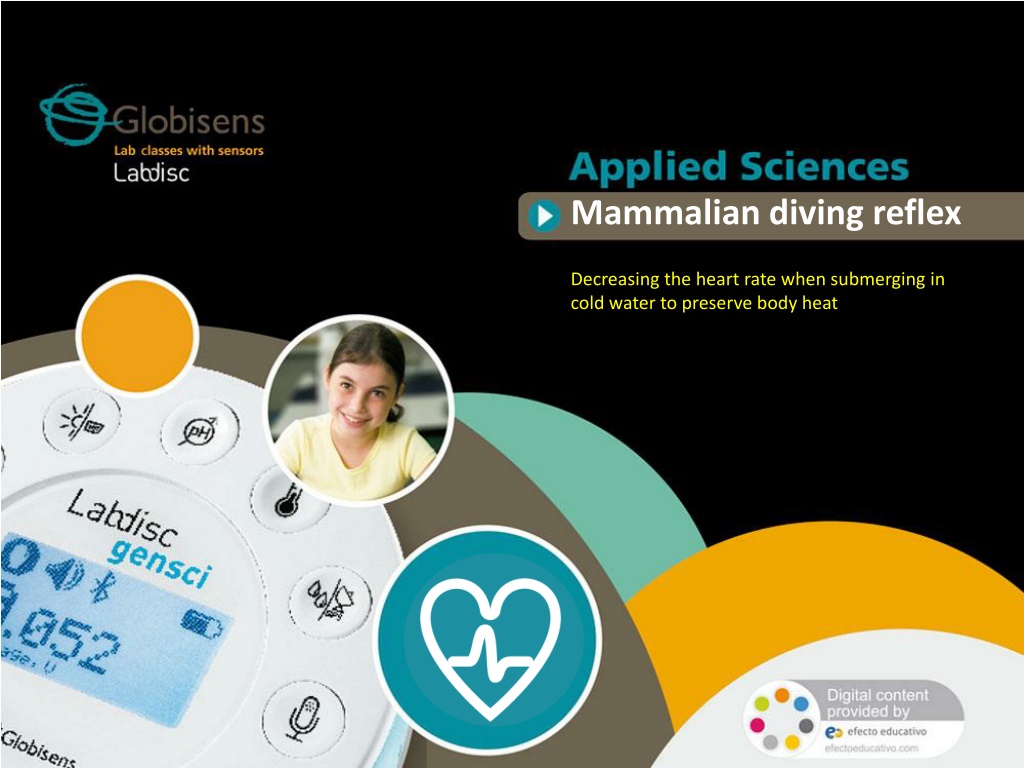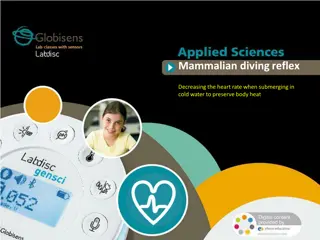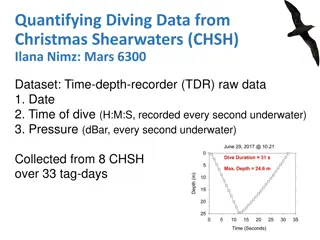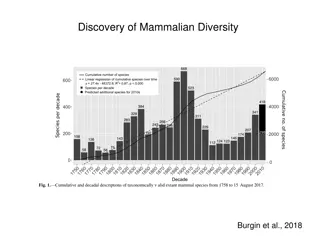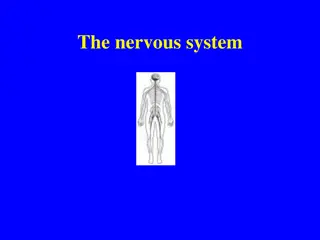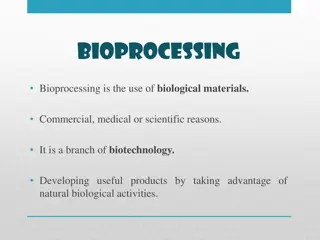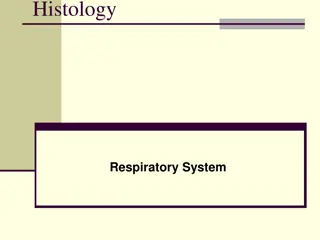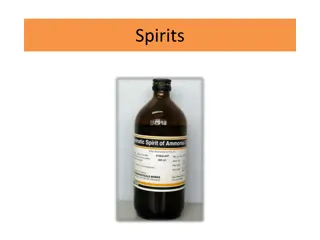Understanding the Mammalian Diving Reflex
Explore the mammalian diving reflex, a fascinating adaptation seen in marine mammals and humans when submerged in cold water. This reflex involves a decrease in heart rate to conserve body heat, allowing for extended breath-holding. Through experiments, learn how the body reacts to underwater conditions and the regulatory mechanisms involved.
Download Presentation

Please find below an Image/Link to download the presentation.
The content on the website is provided AS IS for your information and personal use only. It may not be sold, licensed, or shared on other websites without obtaining consent from the author. Download presentation by click this link. If you encounter any issues during the download, it is possible that the publisher has removed the file from their server.
E N D
Presentation Transcript
Mammalian diving reflex Decreasing the heart rate when submerging in cold water to preserve body heat
Mammalian diving reflex Decreasing the heart rate when submerging in cold water to preserve body heat Objective The purpose of this activity is to corroborate a mammalian adaptation known as diving reflex relating the heart rate, temperature of water and breath-holding capacity. Moreover, a hypothesis will be created and tested using the Labidisc external temperature and heart rate sensors.
Mammalian diving reflex Decreasing the heart rate when submerging in cold water to preserve body heat Introduction and theory One of the most interesting issues in evolutionary history is the adaptation of marine mammals, from terrestrial to aquatic animals. According to paleontological evidence ancestral terrestrial mammals returned to the sea around 25 million years ago, beginning the long history of aquatic habitat. Many current terrestrial mammals are not natural swimmers, but they do swim and dive to survive. This includes human beings who swim for recreational interest and dive for profitable natural products found on the sea floor. Diving mammals are amazingly adapted both in structure and function to survive in an aquatic environment. This includes the mammalian diving reflex.
Mammalian diving reflex Decreasing the heart rate when submerging in cold water to preserve body heat Introduction and theory What do you feel when you are submerged in cold water? Are the sensations different or the same when submerging your limbs, your face or your entire body? What kind of regulations do you think the body makes when you dive? Carry out the experiment activity with your class so that at the end you ll be able to answer the following question: How does our body react when we are submerged in water?
Mammalian diving reflex Decreasing the heart rate when submerging in cold water to preserve body heat Introduction and theory Theoretical The diving reflex in human beings is quantitatively less pronounced than that seen in other natural mammal divers, such as the seal. The diving reflex has been used to indicate the physiological outcome of several mechanisms occurring simultaneously. It is produced by the combination of water touching the face and either voluntary or involuntary (reflex) arrest of breathing. In humans, the diving reflex enables the body to tolerate a low level of oxygen and entails two main changes: Slowing of the heart rate from 10 to 30 % (Bradycardia) and reduction of limb blood flow with a gradual rise in arterial blood pressure (peripheral vasoconstriction).
Mammalian diving reflex Decreasing the heart rate when submerging in cold water to preserve body heat Introduction and theory The physiological shifts saves available rich-oxygen blood for a small circulatory system, including lungs, heart and brain, moreover they help to keep the body s core temperature in cold water. The diving reflex in human beings can be modified by many factors - but most important are water temperature, oxygen tension in arterial blood and emotional factors.
Mammalian diving reflex Decreasing the heart rate when submerging in cold water to preserve body heat Introduction and theory Now students are encouraged to raise a hypothesis which must be tested with an experiment. If you submerge your face into a volume of cold water, how do you expect your heart rate to change?
Mammalian diving reflex Decreasing the heart rate when submerging in cold water to preserve body heat Activity description Students will study the heart rate variation related to holding their breath for as long as possible, while submerging their faces in cold water. They will use the external temperature and heart rate sensors to obtain experimental data and analyze the graphs by means of the GlobiLab software.
Mammalian diving reflex Decreasing the heart rate when submerging in cold water to preserve body heat Resources and materials Labdisc Biochem Heart rate probe Thermocouple Bowl of cold water
Mammalian diving reflex Decreasing the heart rate when submerging in cold water to preserve body heat Using the Labdisc Labdisc configuration To collect measurements configure the Labdisc according to the following steps: Open the GlobiLab software and turn on the Labdisc. Click on the Bluetooth icon in the bottom right corner of the GlobiLab screen. Select the Labdisc you are using currently. Once the Labdisc has been recognized by the software, the icon will change from a grey to blue color . If you prefer a USB connection follow the previous instruction clicking on the USB icon. You will see the same color change when the Labdisc is recognized .
Mammalian diving reflex Decreasing the heart rate when submerging in cold water to preserve body heat Using the Labdisc Click on to configure the Labdisc. Select colorimeter in the Logger Setup window. Enter Manual for the sample frequency.
Mammalian diving reflex Decreasing the heart rate when submerging in cold water to preserve body heat Using the Labdisc Once you have finished the sensor configuration start measuring by clicking Once you have finished measuring stop the Labdisc by clicking
Mammalian diving reflex Decreasing the heart rate when submerging in cold water to preserve body heat Experiment Connect the ear-clip to your finger or to the skin between your thumb and finger. Start by recording pulse and skin temperature, then put your face in the water with the temperature sensor and continue recording.
Mammal diving effect Decreasing the heart rate when seeming in cold water to preserve body heat to preserve body heat Mammalian diving reflex Decreasing the heart rate when submerging in cold water Experiment Experiment Connect the ear-clip to your finger or to the skin between your thumb and finger. NOTE: Before starting the experiment measure the temperature of the water. It should be below 16 C. You can cool the water using some ice cubes. Start with recording pulse and skin temperature, then put your face in the water with the temperature sensor and continue recording Pour the water into a large bowl. The size of the bowl should be able to accomodate your head volume. Submerge your face completely into the water and hold your breath for as long as you can. NOTE: Before starting the experiment measure the temperature of water. It should be below 16 C. You can cool the water using some ice cubes. Pour water in a large bowl. The size of the bowl should contain a head volume. Submerge your face completely into the water and hold your breath as long as you can.
Mammalian diving reflex Decreasing the heart rate when submerging in cold water to preserve body heat Results and analysis Click on tool from the GlobiLab menu to label your actions on the graph. Pick up two points on the temperature curve ( ) to show the extreme values through the experiment. Get the minimum and maximum heart rate values using the statistics tool .
Mammalian diving reflex Decreasing the heart rate when submerging in cold water to preserve body heat Results and analysis How do the results relate to your initial hypothesis? Explain. What was the relationship between the heart rate and water temperature? Did the graph show differences in the heart rate curve behavior before, during and after your face was submerged in the water?
Mammalian diving reflex Decreasing the heart rate when submerging in cold water to preserve body heat Results and analysis The graph below should be similar to the one the students came up with:
Mammalian diving reflex Decreasing the heart rate when submerging in cold water to preserve body heat Conclusion What variables are correlated in this experiment? Did you expect this result? Students should point out that the heart rate and the temperature of the water are correlated variables. They could remember from the theoretical background that temperature is one of the predictor factors in this stressed condition. What are the benefits of decreasing the heart rate underdiving conditions? Students could mention the decrease in heart rate helps a lower oxygen consumption since the heart muscle is working at a lower intensity, however, diving response enables the body to tolerate a low level of oxygen because different physiological shifts are produced.
Mammalian diving reflex Decreasing the heart rate when submerging in cold water to preserve body heat Conclusion What are the physiological mechanisms occurring during the human diving reflex? Students should consider the theoretical background and point out that saving available rich-oxygen blood for lungs, heart, brain and keeping the body s core temperature in cold water is the result of bradicardia, reduction of limb blood flow and peripheral vasoconstriction as well. These physiological shifts work in coordination to reach the short-term adaption to immersion.
Mammalian diving reflex Decreasing the heart rate when submerging in cold water to preserve body heat Activities for further application What negative collateral effect does the mammalian diving reflex have? The ability to perform useful work (for example, escape from danger and to save oneself) declines substantially after 10 minutes of being submerged since the body protectively cuts off blood flow to "non-essential" muscles. What is the most important factor to coordinate simultaneous physiological processes through the diving reflex? Investigate. Students should answer that by holding their breath while experiencing their face submerged in cold water produces a decrease in heart rate and reduction of limb blood flow. This is due to parasympathetic responses from the nervous system which regulate the pacemaker (i.e. heart rate control) and blood pressure by means of the related muscles.
